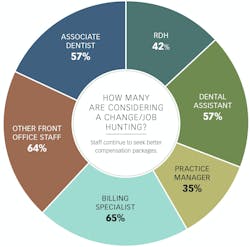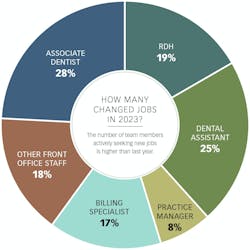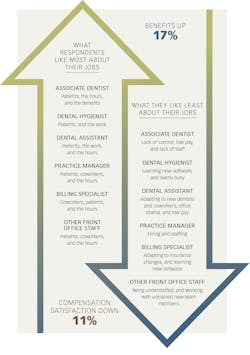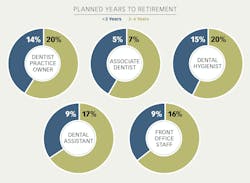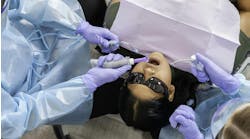Staff exodus and rising dissatisfaction top the list of practice owner headaches this year, despite boosted team member benefits and increased hourly compensation.
In many dental practices, dental assistants and nonmanagerial front office team members are at the highest risk for turnover as income has not kept pace with the rising cost of living.
DentalPost’s most recent survey results provide insights into job search behaviors in the previous year, a forecast for what to expect in the year ahead, and data to help you answer the question, “What can I do more of to retain, recruit, and engage my team members?”
The highlights presented here, along with other data points in the full Dental Salary Report, will help dental practice owners and managers move forward with heightened confidence as they make 2024 business decisions.
For the fifth consecutive year, DentalPost’s annual salary survey casts a spotlight on the state of dental team careers, illuminating the compensation trends and turnover projections that are actively shaping dental practices.
Conducted from August to mid-October 2023, this comprehensive survey engaged the voices of more than 4,300 dental professionals to offer insights into salaries, benefits, job transitions, and retirement aspirations. Takeaways from the survey are highlighted below.
The compensation landscape has changed
General dentists’ compensation: Good news for our readers as results paint the picture of dentists’ income increasing as they transitioned more fully to post-pandemic practice conditions.
- Practice owners: In 2023, the average income rose by 3.72%, reaching $300,273 in 2023.
- Associates: The average income rose by 11.27%, reaching $217,867 in 2023.
Clinical team members’ compensation: The percentage of all clinical team members receiving some combination of employee benefits rose from 70% one year ago to 89% in 2023. This significant rise indicates employers have adjusted to team members’ desires using improved benefits to increase employee satisfaction.
- Dental hygienists: The average hourly rate has increased by 7.85% in 2023 to reach $45.75.
- Dental assistants: The average hourly rate has increased by 8.24% to $25.21 in 2023. However, they are working fewer hours compared to one year ago, so their average total income rose only 4.24%.
Front office team members’ compensation: The percentage of all front office team members receiving some combination of employee benefits rose from 67.5% one year ago to 92% in 2023. Kudos to employers for addressing employee concerns and making impactful changes!
- Practice managers: The average hourly rate has increased by a notable 16.40% to reach $34.21 in 2023.
- Billing specialists: The average hourly rate has increased by only 2.04% to reach $25.00 in 2023.
Front office associates (receptionists):
- The average hourly rate has increased by 6.89% to reach $25.00 in 2023.
Compensation satisfaction has declined
Despite increasing benefits and hourly rate increases, there is a notable decline in compensation satisfaction by an average of 11 percentage points across all positions. Open comments indicate a palpable sentiment of dissatisfaction among primarily dental assistants, front office receptionists, and billing specialists due to:
- Inadequate raises that don’t match the inflated cost of living
- Observations of colleagues securing higher compensation after changing jobs
- Availability of higher-paying jobs outside of the dental sector
Dental professionals, especially dental assistants and front office staff, are likely to continue to seek better compensation packages or explore opportunities outside the sector unless their income needs are adequately addressed.
New job applications are at an all-time high
The number of dental assistants and front office team members actively seeking new jobs right now is higher than one year ago. In addition, the number of dental professionals who report they have no definite plans but might apply for new jobs is also higher than one year ago.
Here’s what they're seeking and where they look for jobs
Associate dentists are seeking career advancement, higher income, and “a better work environment.” Open comments indicate a better environment is likely to be one where they have more autonomy and opportunities to do “bigger cases” and one where practice marketing is attracting the patients they most want to serve.
Patients are at the top of everyone’s mind as dental hygienists are seeking not only higher compensation but an environment in which they can spend more time with each patient. In 5% of comments, physical pain is motivating them to find a more flexible and shorter workweek.
Don't miss: You pay your dental hygienist what?!
Dental assistants and front office staff are seeking higher compensation and a better environment of appreciation. In 3% of comments, they reported concern about the dental practice being in transition to new owners and what that could mean for them.
Job seekers frequently peruse online job postings, and so do dental professionals who “might” want to apply for jobs but do not have definite plans to do so currently.
- More than 70% of all dental professionals look for job opportunities on both dental-specific and nondental-specific online job boards. (Only a portion of the survey respondents are DentalPost clients.)
- More than 30% of employee (associate) dentists additionally work with recruiters, and 25% to 35% of RDHs, dental assistants, and front office staff look for jobs on the social media accounts of other dental practices.
Turnover has been challenging
Survey comments from dentists suggest that many live in fear of team members leaving. One dentist elegantly wrote, “I think I must adjust to the fact that team members will keep leaving for higher pay and benefits. I’m doing everything I can to make them happy, but I fear they will leave anyway.”
With 17% to 25% of team members turning over, there has been a large, adverse impact on the dentists and team members they leave behind. Turnover disrupts the stability of the work environment, creates operational holes to be filled by the remaining staff, and shifts interpersonal dynamics—all of which can affect the quality of patient care during a transitional period.
In an industry that relies heavily on trust and collaboration, the frequent turnover may erode employer-employee trust. Frequent departures can make it challenging for team members to invest emotionally in their workplace relationships. The same goes for patients adjusting to their new oral care providers. Increased communication, trust-building interactions, and intentional focus placed on creating a standout practice culture become vital to maintaining a positive work environment.
This year’s survey affirms that the top three ways to retain top talent are to:
- Provide competitive compensation
- Constantly and consistently pay attention to building and sustaining a positive practice culture
- Demonstrate high appreciation and gratitude
Someday, we may look back and realize that post-pandemic changes and challenges have resulted in a more resilient and happier workforce. Despite the challenges posed by high turnover, dental professionals find meaning in their work by helping others. Those who change jobs are often seeking to achieve higher career satisfaction. The higher we can raise satisfaction within our beloved industry, the higher we elevate the well-being of everyone involved and attract significantly more newcomers to the dental profession. Fortunately, a significant 80% of those who changed jobs in 2023 report achieving their goals in their new roles, and these team members are likely to stay in place for the foreseeable future.
For even more insights, download the full report at DentalPost.
Editor's note: This article appeared in the January 2024 print edition of Dental Economics magazine. Dentists in North America are eligible for a complimentary print subscription. Sign up here.
John Riley is the executive vice president of Alatus Solutions, advising top clinical dentists with proven marketing and hiring strategies. With more than 21 years of experience in the dental industry, his passion is coaching for a culture for practice growth. He’s partnered with nearly a thousand practices, significantly impacting their profit and EBIDTA by implementing marketing and top-talent hiring tactics. His passion to mentor dentists and team members, helping them break through the ceiling of complexity, brings him great joy.
Alatus Solutions is a goal-focused, results-fueled MarTech firm anchored by Amplify360, illumitrac Software, and DentalPost. It provides specialized solutions and dedicated support to dental practices and organizations. Featuring a set of meaningful marketing, membership, and hiring solutions and services, its all-encompassing portfolio takes people and practices from where they are to where they want to be.


